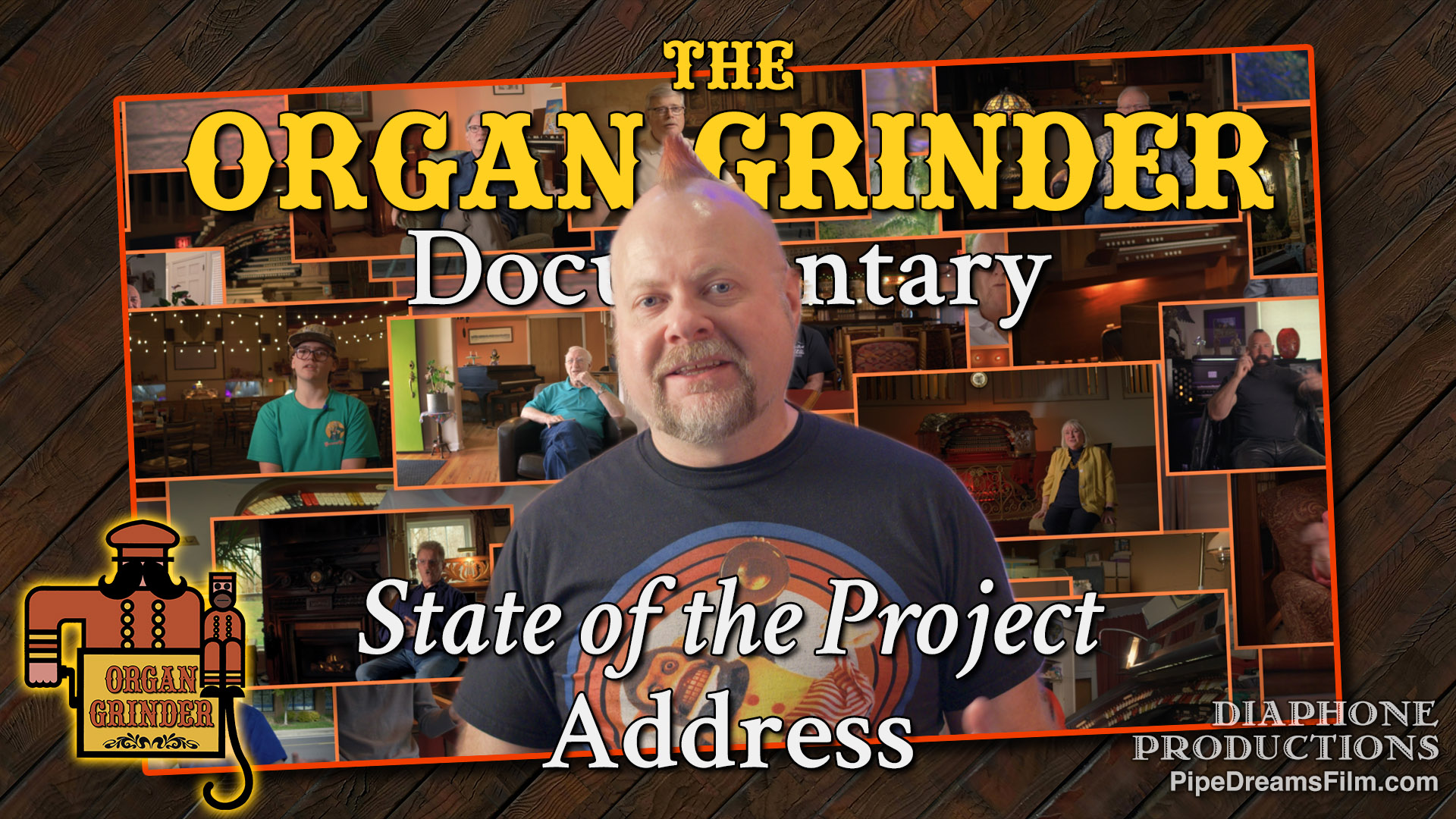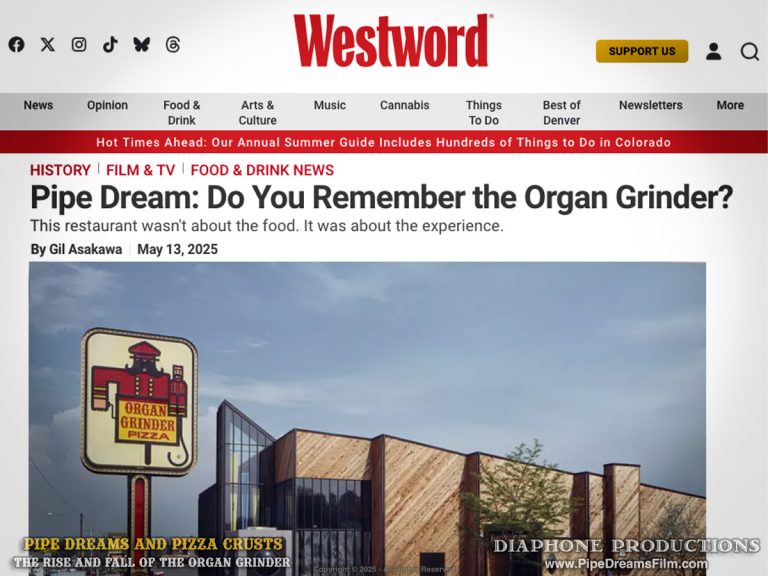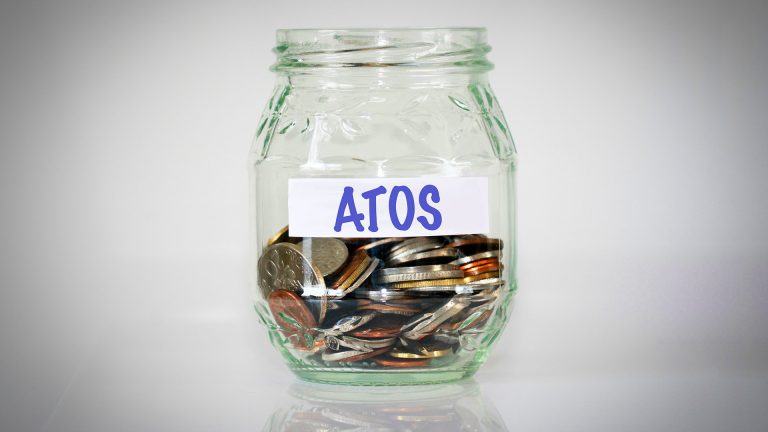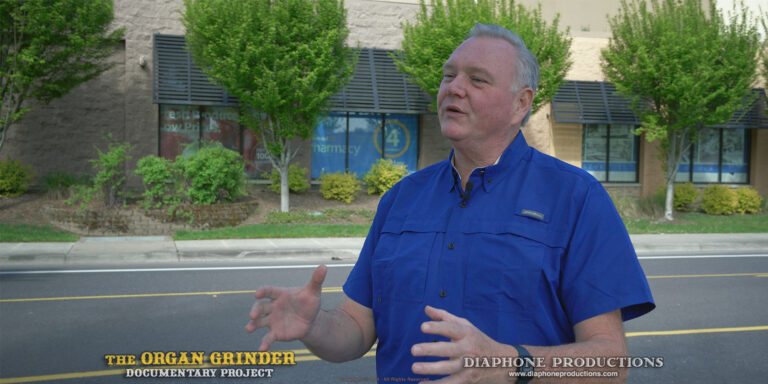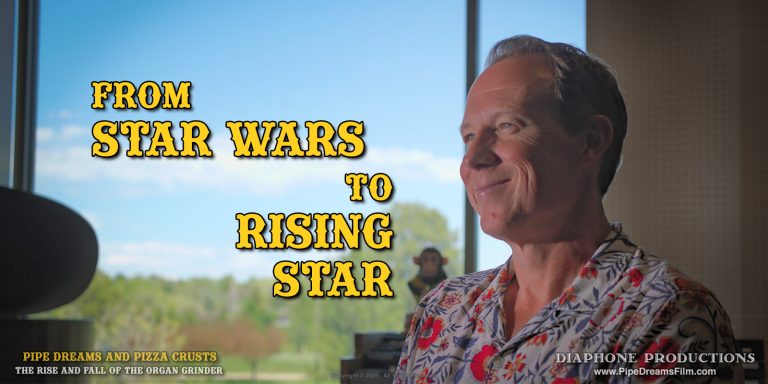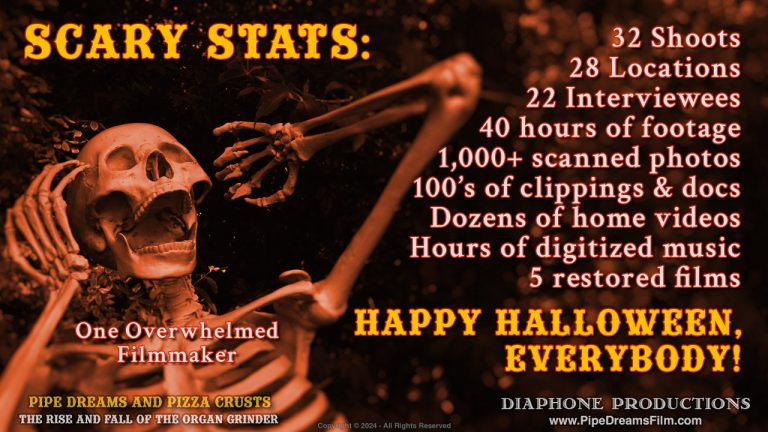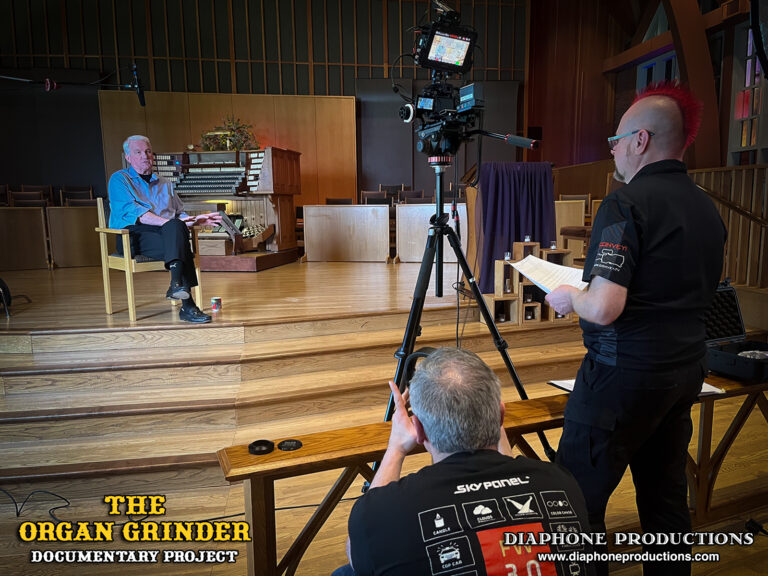This is a big update about everything that has happened with the Organ Grinder documentary over the past 22 months, plus what’s coming next, and how people can help me complete principal photography.
Correction: In the video I refer to Howard Vollum as the “founder of Tektronix”. There were in fact four original co-founders of Tektronix: Glenn McDowell, Jack Murdock, Miles Tippery, and Howard Vollum.
If you prefer to read, rather than watch the video, here is a transcript:
Hello – I’m Bob Richardson, I’m a filmmaker, and more than a little bit insane, because for the past 22 months, I’ve been working nearly full-time making a documentary about the Organ Grinder restaurants.
I’m making this video to update fans and backers about the state of the project.
It’s divided into three sections – what’s been done, what’s coming next, and how people can help.
You can use the YouTube chapter functions to skip between sections.
As I talk about places you can visit on the web, links will appear. The links are also listed in the YouTube description.
OK, here we go…
So, what’s been done? Or, sometimes people ask, “just what the heck have you been doing all this time?”
Why does a film about a pair of restaurants take so long to make?
The answer is it’s a surprisingly huge story. I had no idea about the massive scope of it when I started.
The Organ Grinders and their ilk not only have a fascinating history, but echoes and influences in today’s world, including some unexpected current events.
The journey has taken me to 48 locations in nine states, meeting over 70 people – Including the original founders and builders, performers, staff, people with historical knowledge and, of course, the fans.
I’m really grateful to all who have been interviewed, who’ve shared their lives and experiences.
This is their story, and I’m privileged and honored to be the one who gets to tell it.
Take a look at the current credits – this has become a Big Deal.
But it makes sense: The Organ Grinder was a Big Deal, and it deserves a Big Movie.
Let’s look at the overall story arc:
The story of the Organ Grinder really begins with the grand movie palaces that once were in every city – with their giant theater pipe organs providing the soundtrack for silent films.
As sound came to films, and as the suburbs expanded, and movie palaces began to decline, these pipe organs were discarded or destroyed.
Ironically, if it weren’t for the destruction of a movie palace in Portland, The Oriental Theatre, there would be no Organ Grinder.
That’s where co-founder Dennis Hedberg obtained the Wurlitzer that became the core of the first Organ Grinder.
We’ve obtained and restored film footage of the Oriental’s tragic fate.
I’ve traveled to Wisconsin, to meet a man who has been working passionately for decades to restore a derelict movie palace. We talked about the role these theaters had in their communities.
Next is a chapter on The Collectors – the people, like Dennis, who rescued these instruments.
There were once over two thousand Wurlitzers that could be experienced by the public. Now, there are about fifty.
Without the collectors, who learned everything they could about these instruments, there might be none left at all.
I’ve visited a place called the Basement Bijou – Built in the 1950s by one of the first collectors, Fred Hermes, Sr., it’s where the largest five-manual Wurlitzer the factory ever built sits in a two-story movie palace – in the basement of a suburban home.
The décor consists of cast plaster, statues, and fixtures preserved from over 25 theaters around the country.
There’s even footage of another theater’s demolition – the Venetian – and many pieces from there are preserved in the Basement Bijou.
The film explores what happens when a collector passes away – and the difficulty of finding homes for their possessions – trying to cheat the landfill yet again.
I visited a current collector who has a pipe organ in his home, which was once touched by Liberace in its original venue.
He had a trove of documents covering the many pipe organ restaurants that were once all over the place.
Which brings the story to the 1960’s and 70’s, when the Pizza and Pipe Organ phenomenon was sweeping North America.
Over time, at least a hundred such restaurants were built.
I’ve interviewed Bob MacNeur, co-founder of the Paramount Music Palace in Indiana, which rivaled the Organ Grinder in scope and in fame.
Bob is still at it in retirement, restoring a Wurlitzer in his backyard shop.
The Organ Grinder was not the first Pizza and Pipe Organ restaurant, nor the last, but in my view it elevated the format to new heights.
I’ve spoken extensively with co-founder Dennis Hedberg, who installed and expanded the pipe organs in both Portland and Denver.
Dennis ultimately wound up buying the Portland location, along with his wife Judy, who did the books.
Thanks to contributed Frequent Flyer miles, I traveled to Hawaii to interview Jerry Forchuk.
Jerry and his brother Paul were the entrepreneurs behind the Organ Grinder, and other well-known institutions like Earthquake Ethel’s disco.
They were also real estate developers- and the fate of one of those developments is an important part of the story.
The Organ Grinder is closely tied the early high-tech industry in Oregon.
Howard Vollum, the founder of Tektronix – and a big fan of pipe organs – gave many of the people behind the tech of the Organ Grinder their start.
Howard even played a role in keeping the Portland restaurant open in the 80s, when it could have been doomed.
But what fans remember the most is enjoying the performances, the atmosphere, and all of the fun.
I’ve had the privilege of interviewing nearly all of the performers who worked there who are still with us – many of whom are still performers today.
Some tour internationally, others have TV and film careers, and one was a producer for Motown records.
In addition to the musicians, I’ve interviewed people like Vicki Buck, who cared for and performed with the live monkeys at the Portland location.
Did you know there were live monkeys at the Organ Grinder in the early years?
I’ve interviewed Steve Spangler, the teen-age magician at the Denver Organ Grinder. You may know Steve from his viral videos showing the effects of putting Mentos in Diet Coke!
I’ve even interviewed the youngest staff performers from Portland and Denver, who began their careers at ages eleven, twelve, and fourteen, respectively.
Plus, I’ve talked to Dennis and Judy’s kids, who literally grew up in the restaurant.
Can you imagine having the Organ Grinder and all its arcade games as your personal playground after school?
The Organ Grinder had international fame, and had big plans to expand nation-wide.
There were copycats – such as a restaurant in Florida whose owner photographed the Portland restaurant and copied the look.
And in Canada, there were two restaurants called “Organ Grinder” – much beloved, but with different ownership and a different vibe.
I interviewed a performer from the Toronto location to talk about the history of those places.
There were also multiple celebrity connections – noy only because of the restaurant’s fame – but because of the Hollywood friendships that the Forchuks maintained.
Sadly, many of those celebrities are no longer with us – but some are, and some of those stories are being explored by the film.
After the initial glory days of the Organ Grinder, with lines around the block to get in, the restaurants experienced a gradual decline.
There was no one, single cause – changing tastes, some bad business decisions, and a bit of hubris was to blame – but also new competition from places like video arcades and Chuck-e-Cheese, and even changing transportation and land-use patterns.
Sometimes, when discussing the eventual demise of the Organ Grinder, people can get quite emotional. Several have teared-up on-camera.
This was especially true in Denver, where the restaurant changed hands multiple times, and its closure came without warning.
I’ve interviewed the last person to play in Denver in 1988. The news of the closure came right in the middle of his set, and the audience wouldn’t let him leave – he played for an extra hour, and his tip jar overflowed.
Thanks to fans and archivists, we have dozens of hours of videos, and hundreds of photos and documents. Even the original architectural drawings for both Portland and Denver are coming to light.
Plus we’ve unearthed and restored professional films and TV shows featuring the Organ Grinder. The Organ Grinder was part of a nationally-televised game show – twice!
We also have the very final moments of the Portland Organ Grinder from 1996: The final song performed, the applause and tears afterward, and the shutting down of the console and the lights.
I’ve even interviewed someone who was in the audience at that poignant moment, who went on to found another institution that is popular in both Portland and Denver.
But the film doesn’t end with the closure of the Organ Grinder and people mourning its loss.
It can’t end there – because the Organ Grinder’s story doesn’t end there.
The film covers multiple avenues of hope – what’s happening now, and what we might look forward to in the future.
There are two remaining Pizza and Pipe Organ restaurants – and a third possibly making a comeback.
I’ve visited Organ Piper Pizza in Milwaukee – in business since the 70’s – to learn what makes it sustainable.
I’ll soon travel to Arizona to get the Organ Stop Pizza story as well. There are a number of components from the Organ Grinder there.
In Illinois, Beggars Pizza, a regional chain, has a location that used to be a pipe organ restaurant. A 17-year-old enthusiast has helped get the instrument functioning again. It’s now played for patrons a couple of nights a week.
I’ve often described the Organ Grinder as “Weird and Wonderful”. And the film explores what Weird & Wonderful things people are doing with pipe organs today.
Did you know that the world’s largest theatre pipe organ was built inside the warehouse of a lip balm factory?
The film features popular YouTuber Sam Battle who’s known as “Look Mum No Computer”. Sam, knowing little about pipe organs, rescued and restored a discarded instrument, as hundreds of thousands of viewers followed his project. Sam may be inspiring a whole new generation of collectors.
The project also spent a week following “The Next Generation” – the people under 25 who are learning to perform on and maintain these instruments.
Many of them came to discover and love the instrument without first hearing it in theaters or pizza parlors. We explore whether this is a dying art form, or if there is new life, new ideas, and new growth for the pipe organ.
Finally, there is something in the works – something special – that isn’t quite ready to be discussed publicly – which could help ensure a future for the theatre pipe organ and its legacy.
It’s not another Organ Grinder, nothing quite of that scale, but – if successful – it will provide a feel-good ending for the film. Fingers crossed.
So, what comes next?
Well, after visiting nine states, principal photography is ninety percent complete.
What does 90% mean?
Well, it doesn’t mean that the film is 90% done – but what it does mean is that the core story, from beginning to end, is nearly acquired. There’s just a few things left that are important to gather.
After that, comes a months-long period of editing and finishing, to get the film ready for presentation.
More on that in a bit.
There are three states left to visit – California, Nevada, and Arizona.
I’m planning that road trip right now – and I’m hoping to embark in the next couple of weeks.
The trip will pick up interviews of people who were involved in the early years, of people who were witnesses to key moments, and cover the origins of the Pizza & Pipe Organ format.
I’ll be interviewing someone who performed at what is regarded as the very first Pizza and Pipe Organ restaurant – “Ye Olde Pizza Joynt” in Hayward, California.
And I’ll be visiting somewhere that is significant in the life of a key Organ Grinder performer, who recently left us.
And there’s a potential opportunity – not yet confirmed – to interview a television and film celebrity, who often patronized the restaurant. This celebrity is of a stature where an appearance fee is appropriate. If I’m able to raise more funds beyond what is needed for the road trip, it will help with that fee. Contact me if that intrigues you, and you’d like to help.
The trip will conclude with a visit to Organ Stop Pizza – the largest place left – where you can experience something like the Organ Grinder.
Along the way, I’ll be filming historic locations for “then and now” shots.
That will bring the story to 99% – enough to complete the movie.
There are other things that would be good to cover, but those are optional, and can be completed without additional travel.
You may be wondering, “How is he going to cram all of this material into one movie?”
Well, I’ve been wondering that myself!
The plan is to make three versions:
One, for general audiences. It will be fast-paced, and will convey the feeling of what it was like – the whirlwind of activity, the madness, and the fun.
I want people to come away with a sense of wonder and excitement, as though they’ve experienced the Organ Grinder itself for the very first time.
This is the version that will go to film festivals and events.
Next is planned an extended edition – showing more of people’s interviews, exploring more tangents, and providing more facts and figures – but without being overwhelming.
Then, I plan what I’m calling the “excruciating edition” – for nerds like me who want to have every last detail. It may be presented in a mini-series format, rather than as a long film.
Plus, there will be bonus features and extended interviews posted to the YouTube channel – something that’s already been happening over the past year.
Back to the general-audiences version: The plan is to show it at film festivals in actual theaters.
I think it’s important that a film featuring theatre pipe organs should be exhibited in a real movie theatre, with a full audience.
The hope is that a buyer or distributor at the festivals will be interested in bringing the documentary to a wider audience.
I’m making the film with the technical guidelines used by streaming services like Netflix.
I don’t have a distributor yet – but if I’m successful, the film’s quality will be suitable for those outlets.
Now that you know the plan, let’s move on to what’s needed to make it happen.
Through the course of this project, people have been very generous.
There was an initial Indiegogo campaign, and then an ongoing fundraiser on the web site, PipeDreamsFilm.com, with merchandise and other perks.
To-date, there’s been over 200 contributions – raising over $38,000 – or about 35% of the film’s budget.
The median contribution is just $85 – You can see how modest contributions really add up.
You may be wondering, if principal photography is 90% done, why is there 65% of the budget left to go?
My intention is to get the film “festival ready” – to be able to be shown in theaters.
For that, there are a number of significant post-production costs – the largest of which is music licensing.
One of the things that made the Organ Grinder great, was that they played a lot of contemporary pop music and movie themes, from Abba to The Who, from Star Wars to Jurassic Park.
Some of the music can be used in the film under copyright law as “Fair Use”. But, if you fall outside of that narrow definition, you must negotiate a license with the publishers.
I’ve had initial conversations with Disney, Warner, and Universal about licensing, and it’s not cheap.
And to go the “Fair Use” route, you still need a copyright lawyer to issue an opinion every piece of content.
It sounds like a bureaucratic nightmare, but I’m prepared for it. I’ve been documenting every step of the process, to try and keep things problem-free going forward.
Beyond music licensing, the budget includes the cost of an original score, to be written and performed by composer Nathan Avakian, who’s also a big Organ Grinder fan.
You can hear Nathan’s music in the trailer, how it weaves seamlessly with vintage recordings from the restaurant.
Additional costs include footage licensing, hiring drone photographers for certain establishing shots, and conducting some remote interviews that will augment the story.
Finally, the budget includes the rental of a local theater for a premiere event, and travel to film festivals.
I’ve poured much of my life – and my savings – into this project – you might call it an obsession.
Making the movie, rather than working for my usual clients, has put a huge dent in my income.
People’s contributions to-date are responsible for keeping this going – and I’m immensely appreciative. And I want to be sure people are confident that their contributions are being put to good use.
Since the beginning of the crowdfunding, I’ve been transparent about how the money is spent, and what’s been accomplished.
For more info, and to see the latest numbers, visit the Transparency page on the web site.
Now, here’s the ways you can help me wrap up principal photography:
One, obviously, is money. A generous contributor has given a huge chunk of what’s needed for the final road trip. But more is necessary for incidentals and unexpected events.
I can work for nothing, but I still gotta eat, and the mortgage doesn’t pay itself while I’m away from home.
I’m hoping to raise an additional $2,000 in the next two weeks. It’s ambitious, but people have stepped up before, like when I did the Midwest road trip, visiting five states.
Please explore the options in the Crowdfunding Shop on the web site. You can make a direct contributions starting at $5. There is merchandise like CDs, posters, postcards, and T-Shirts.
Sales of the CDs also go to benefit youth scholarship programs at the American Theatre Organ Society.
People who contribute $50 or more get screen credit in the final film, and larger contributions can have Producer credit and an IMDB listing.
At the Executive Producer level, contributors have the right to inspect the books and to see work-in-progress.
There are sponsorships available too – sponsors can have their logo on the web site and in the credits.
People have also contributed equipment and accessories. This project is always devouring hard drives with backups of raw footage, and equipment occasionally breaks.
There’s an Amazon wish list set up for people who’d like to help in that way.
Additionally, my 10-year-old laptop is on its last legs – and it was never really suitable for working with this kind of footage.
If anyone has a more recent MacBook that can be loaned or donated – it would be tremendously helpful for this road trip.
It doesn’t have to be brand new – just something with an M-series chipset and 16GB of RAM – used ones go for about a thousand.
People sometimes ask about tax deductibility.
Well, this project is not a nonprofit, so contributions and purchases are not tax-deductible.
However, a local nonprofit theater offers what is called “Fiscal Sponsorship”.
A donor gives to the theater, and they take a small cut to support their operations, and the rest is passed to the filmmaker.
This is usually tax-deductible, but of course, consult your tax advisor.
I hope you’ll consider purchases in the shop, or contributions – if you have the means.
This is a chance to say you were a part of something – that you helped make the movie happen.
On a personal note – I must say that I see the state of the world, and the turmoil of our current economy, and I feel bad asking for money. Putting everything into this film has made me acutely aware of costs, and having to pinch pennies. I understand the stress faced by those who can’t make ends meet right now.
Without people’s help, and the hard work of my husband at his day job – I’d have to give this up.
And it just tears me up, that while I’m off making a movie about something amazing and wholesome and uplifting, our politics have descended into authoritarianism, violence, and chaos.
I sincerely hope, that if I am successful in completing this film, that it’ll bring a little light – a little hope back into the world.
Not that I’m Pollyannaish about this – The Organ Grinder opened and had its best attendance during the peak of the Vietnam War. Richard Nixon was still in office, and the Watergate scandal was in full bloom.
Perhaps people back then craved an escape to something wonderful as much as we do now.
But, enough digression – There are other ways – Besides money – that people can help.
As mentioned, people have provided videos and photos, but more are needed – especially from Denver.
Because Denver closed before compact camcorders were common, we have very little video. Even still photos of people enjoying birthday parties or special events will be very helpful.
And a big way you can help is simply by word-of-mouth. Tell your friends to check out the web site and the trailer – The more people who know about the project, the more who might contribute.
If you have connections at a newspaper or TV station, getting coverage of the project helps immensely.
Many people have joined our Facebook group and our mailing list after seeing news articles and TV appearances.
There have been helpers who have worked on-set, or have provided services such as film restoration and transcription.
Coming up, I could use the help of graphic artists and animators, and experts in 3D modeling and rendering, to implement some ideas that would really enhance the film.
And, if you’re a lawyer with copyright or entertainment law experience, please get in touch!
On previous road trips, people have donated frequent flyer miles. This last trip will be by car, but hotel points for lodging – or if you happen to have a spare bedroom or an empty Air BnB along the route you can make available for a couple of days – it would be very useful.
If you’re in Southern Oregon, the I-5 or coastal corridors in California, or Palm Springs, Reno, or Phoenix, and want to help, please get in touch.
And finally, people can help simply by watching TV! The YouTube channel is growing, but it isn’t yet eligible for revenue. It needs about 50 more subscribers and a few hundred more “watch hours” every month.
If you haven’t subscribed, please do. “Like and Subscribe” is a cliché, but it’s also true – it really works, and it will get the project more exposure.
So, for a dose of nostalgia, put on one of the longer videos, like the Organ Grinder Time Capsule, the “Farewell Concert”, or the Christmas Special, and just let it play. It will really help with the watch-hours.
I’ll be putting out more long-form videos to enjoy during the editing phase.
Ok, that was a lot of information – thank you for sticking around until the end.
I hope you can see just what a big story this is, and that you have faith that the project will deliver.
Again, I really appreciate everyone’s support – I’ve only gotten this far because of it.
Thank you for watching, and for helping to keep the dream of the Organ Grinder alive!
Links in the video:
Project Home Page
https://PipeDreamsFilm.com
Main Credits
https://PipeDreamsfilm.com/main-credits/
YouTube – “Before the Dark”
https://youtu.be/S_gYHxPv8bU
The Kenosha Theatre
https://KenoshaTheatre.com/
Basement Bijou
https://pipedreamsfilm.com/blog/do-go-in-the-basement/
YouTube – “Requiem for the Venetian”
https://youtu.be/1yRsHjDCS88
List of Pipe Organs in Restaurants
https://hotpipes.eu/Restaurant-Organ-List.html
Vintage TEK Museum
https://vintagetek.org/
Organ Piper Pizza
https://organpiperpizza.com/
Organ Stop Pizza
https://organstoppizza.com/
Beggars Pizza – Lansing, IL
https://beggarspizza.com/locations/lansing
Carma Labs Organ
https://pipedreamsfilm.com/blog/the-carmex-pipe-organ-is-for-the-birds/
Look Mum No Computer
https://lookmumnocomputer.com/
Ye Olde Pizza Joynt
https://sfgate.com/food/history/article/This-Bay-Area-pizza-chain-rose-to-fame-in-the-16378714.php
YouTube Channel
https://youtube.com/@DiaphoneProductions
Fair Use – Wikipedia
https://en.wikipedia.org/wiki/Fair_use
Nathan Avakian
https://AvakianMusic.com/
Teaser Trailer
https://youtu.be/wSsAhcKyBAU
Transparency Page
https://pipedreamsfilm.com/transparency/
Crowdfunding Shop
https://pipedreamsfilm.com/shop/
American Theatre Organ Society
https://atos.org/activities
Amazon Wish List
https://amazon.com/hz/wishlist/ls/35EJHBO4DJ90K
Hollywood Theatre Fiscal Sponsorship
https://hollywoodtheatre.org/film-action-oregon-fiscal-sponsorship/
Facebook Group
https://facebook.com/groups/organgrinderfilm
Contact Us
https://pipedreamsfilm.com/contact/
Music:
Performed by Jonas Nordwall
(Trailer Music Composed and Performed by Nathan Avakian)
Song List (in order of first play):
- Can’t Smile Without You
- Don’t Ask Me Why
- Through the Eyes of Love
- Sheik of Araby
- Sing, Sing, Sing!
- I can’t Stop Loving You
- Slavonic Dance
- You Do Something to Me
- Fernando
- The Touch of Your Hand
- Wedding of the Winds
- Nimrod
You can help support the project by purchasing from the Crowdfunding Shop.

